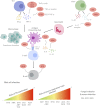Impact of Host Genetics and Biological Response Modifiers on Respiratory Tract Infections
- PMID: 31134083
- PMCID: PMC6513887
- DOI: 10.3389/fimmu.2019.01013
Impact of Host Genetics and Biological Response Modifiers on Respiratory Tract Infections
Abstract
Host susceptibility to respiratory tract infections (RTI) is dependent on both genetic and acquired risk factors. Repeated bacterial and viral RTI, such as pneumonia from encapsulated microorganisms, respiratory tract infections related to respiratory syncytial virus or influenza, and even the development of bronchiectasis and asthma, are often reported as the first symptom of primary immunodeficiencies. In the same way, neutropenia is a well-known risk factor for invasive aspergillosis, as well as lymphopenia for Pneumocystis, and mycobacterial infections. However, in the last decades a better knowledge of immune signaling networks and the introduction of next generation sequencing have increased the number and diversity of known inborn errors of immunity. On the other hand, the use of monoclonal antibodies targeting cytokines, such as tumor necrosis factor alpha has revealed new risk groups for infections, such as tuberculosis. The use of biological response modifiers has spread to almost all medical specialties, including inflammatory diseases and neoplasia, and are being used to target different signaling networks that may mirror some of the known immune deficiencies. From a clinical perspective, the individual contribution of genetics, and/or targeted treatments, to immune dysregulation is difficult to assess. The aim of this article is to review the known and newly described mechanisms of impaired immune signaling that predispose to RTI, including new insights into host genetics and the impact of biological response modifiers, and to summarize clinical recommendations regarding vaccines and prophylactic treatments in order to prevent infections.
Keywords: biological response modifiers; immunogenetics; inborn errors; primary immunodeficiencies; respiratory tract infections.
Figures

Similar articles
-
The host immune response in respiratory virus infection: balancing virus clearance and immunopathology.Semin Immunopathol. 2016 Jul;38(4):471-82. doi: 10.1007/s00281-016-0558-0. Epub 2016 Mar 10. Semin Immunopathol. 2016. PMID: 26965109 Free PMC article. Review.
-
Human inborn errors of immunity underlying superficial or invasive candidiasis.Hum Genet. 2020 Jun;139(6-7):1011-1022. doi: 10.1007/s00439-020-02141-7. Epub 2020 Mar 2. Hum Genet. 2020. PMID: 32124012 Free PMC article. Review.
-
Ageing and respiratory infections: the airway of ageing.Immunol Lett. 2014 Nov;162(1 Pt B):323-8. doi: 10.1016/j.imlet.2014.06.009. Epub 2014 Jun 25. Immunol Lett. 2014. PMID: 24973652 Review.
-
[The pulmonological manifestations of rheumatoid arthritis].Orv Hetil. 2008 Jul 20;149(29):1355-61. doi: 10.1556/OH.2008.28385. Orv Hetil. 2008. PMID: 18617467 Review. Hungarian.
-
Respiratory infections associated with anti-TNFα agents.Med Mal Infect. 2017 Oct;47(6):375-381. doi: 10.1016/j.medmal.2017.05.002. Epub 2017 Jun 9. Med Mal Infect. 2017. PMID: 28602386 Review.
Cited by
-
Genotypic and Phenotypic Characterization of Staphylococcus aureus Isolates from the Respiratory Tract in Mechanically-Ventilated Patients.Toxins (Basel). 2021 Feb 6;13(2):122. doi: 10.3390/toxins13020122. Toxins (Basel). 2021. PMID: 33562023 Free PMC article.
-
Comparative analysis of machine learning approaches for predicting respiratory virus infection and symptom severity.PeerJ. 2023 Jun 30;11:e15552. doi: 10.7717/peerj.15552. eCollection 2023. PeerJ. 2023. PMID: 37404475 Free PMC article.
-
Effects of host genetic variations on response to, susceptibility and severity of respiratory infections.Biomed Pharmacother. 2020 Aug;128:110296. doi: 10.1016/j.biopha.2020.110296. Epub 2020 May 29. Biomed Pharmacother. 2020. PMID: 32480226 Free PMC article. Review.
-
Airborne transmission of biological agents within the indoor built environment: a multidisciplinary review.Air Qual Atmos Health. 2023;16(3):477-533. doi: 10.1007/s11869-022-01286-w. Epub 2022 Nov 28. Air Qual Atmos Health. 2023. PMID: 36467894 Free PMC article. Review.
-
Role of Genetic Variants and Gene Expression in the Susceptibility and Severity of COVID-19.Ann Lab Med. 2021 Mar 1;41(2):129-138. doi: 10.3343/alm.2021.41.2.129. Ann Lab Med. 2021. PMID: 33063674 Free PMC article. Review.
References
-
- World Health Organization Global Tuberculosis Report 2018 (WHO/CDS/TB/2018.20). Geneva: World Health Organization.
Publication types
MeSH terms
Substances
LinkOut - more resources
Full Text Sources

